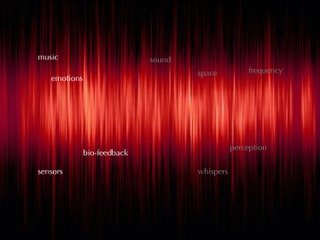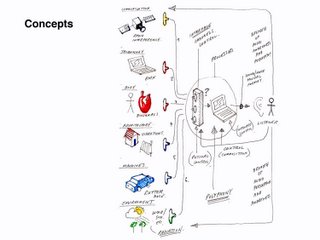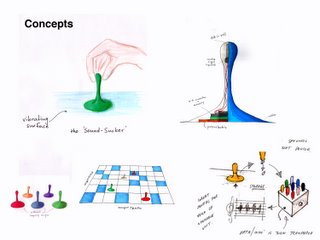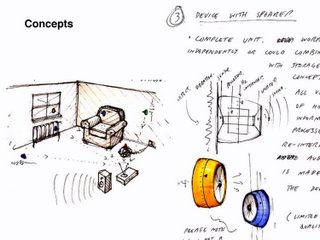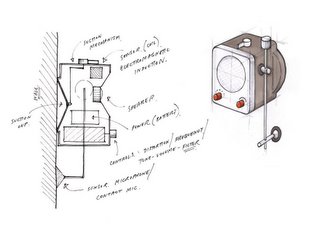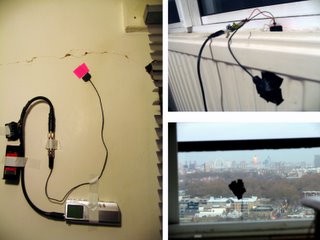madsounds
Madsounds is a name for a project on sound & music currently undertaken at the Royal College of Art. This blog serves an archive for our thoughts and work and as a communication tool betwenn us. MAD is Manolis and Duncan, MA Indusrtial and Product Design students at the RCA.
Saturday, January 21, 2006
Thursday, January 12, 2006
Microphone evaluation
We attached the piezo buzzer, the Shadow guitar pickup and the piezoelectric film on a window and recorded their response to evaluate their quality.
After the recordings we performed a Fourier spectrum analysis of the sound-data.
Piezo-film analysis:

Piezo-buzzer analysis:

The comparisson shows a better response of the piezo-film, especially in the mid-range frequencies. Second came the guitar with the buzzer last, as expected.
Another factor that we evaluated was the unwanted noise levels picked up by the mics. Again, the piezo-film showed the lowest noise levels compared to the other two.
Monday, January 09, 2006
Microphone+Preamp development
 Microphone development from up-left, clockwise:
Microphone development from up-left, clockwise:- Piezo-element used in cheap sound-buzzers. Piezoelectric material is layered on a thin copper substrate. We used the 'inverse' effect of the buzzer, hence mechanical vibtrations are converted to weak electrical signals.
- Small electret-type microphone.
- Acoustic guitar pick-up (Shadow SH711). The piezoelectric element is of higher quality and better shielded against noise.
- Piezo-electric film which offers several advantages, e.g. flexibility
 Because of high-impendance and low signal of acoustic pickups, we tried using different pre-amp circuits in order for better recordings. Most of these circuits were taken out of cheap commercial electronics. By trying different configurations of we found out the right choise of pre-amp is crucial to get a clear signal as possible, especially if it is combined with filtering capabilties (EQ).
Because of high-impendance and low signal of acoustic pickups, we tried using different pre-amp circuits in order for better recordings. Most of these circuits were taken out of cheap commercial electronics. By trying different configurations of we found out the right choise of pre-amp is crucial to get a clear signal as possible, especially if it is combined with filtering capabilties (EQ).
Microphone-preamp combinations.

During recording, it was evident that external noise was an issue. One factor which infunced that was cables and exposed circuits. We replaced excisting wires with special shielded audio cable.
First tests
This was posted a month ago, but I post it again for reasons of consistency with the next post.
Piezo attached on wall..

Second version with amplifier..

Third version with stronger amplifier..

We attached the piezos on various places around my flat. These include:
- freezer
- thermostat
- radiator
- water pipes
- window
- coffee-maker..
radiator sounds..

the sounds of London from my window..

These sounds were recorded on a computer. Listening to the 'raw' sound files we realized that it is difficult to distinguish the various elements (e.g. flowing water, motors, voices etc.) so we used special software (Sound Studio) to filter through different frequencies..

Unfortunately we haven't found a way yet to upload sounds on the blog..
Wednesday, January 04, 2006
Sound Effects techniques
from Wikipedia's 'Sound Effects' site:
'... As the car example demonstrates, the ability to make multiple simultaneous recordings of the same subject—through the use of several DAT or multitrack recorders—has made sound recording into a sophisticated craft, and allows the sound effect to be shaped by the sound editor or sound designer, not just for realism, but for emotional effect.
Once the sound effects are recorded or captured, they are usually loaded into a computer integrated with an audio non-linear editing system. This allows a sound editor or sound designer to heavily manipulate a sound to meet his needs.
The most common sound design tool is the use of layering to create a new, interesting sound out of two or three old, average sounds. For example, the sound of a bullet impact into a pig (from the above example) may be mixed with the sound of a melon being gouged to add to the "stickiness" or "gore" of the effect. If the effect is featured in a close-up, the designer may also add an "impact sweetener" from his library. The sweetener may simply be the sound of a hammer pounding hardwood, equalized so that only the low-end can be heard. The low end gives the three sounds together added weight, so that the audience actually "feels" the weight of the bullet hit the victim. If the victim is the bad guy, and his death is climactic, the sound designer may add reverb to the impact, in order to enhance the dramatic beat. And then, as the victim falls over in slow motion, the sound editor may add the sound of a broom whooshing by a microphone, pitch-shifted down and time-expanded to further emphasize the death. If the movie is a science-fiction film, the designer may phaser the whoosh to give it a more sci-fi feel. (For a list of many the sound effects processes available to a sound designer, see the bottom of this article.)
'Vibroblaster' and 'iZ'-synthesizer

The vibroblaster is similar to the Soundbug concept, probably more robust, smaller and maybe more powerfull, but more expensive and unclear yet whether it has a mounting mechaqnism (sucker).
Vibroblaster

What about this funny creature as a synthesizer?
"iZ lets you create your own music by pressing his belly to start and select from a choice of beats. Once you find a sound you like, move iZ's right ear to add a little rhythm to the equation, and turn his left ear to find a suitable musical lead.."
iZ
watch the video..
iZ video
